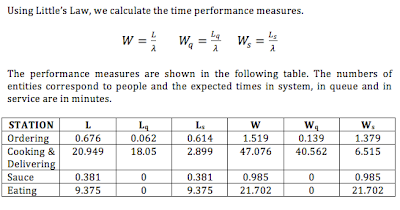Hello everyone!
For this week, we have to model the system based on the real distributions of times, obtained a few weeks ago with Crystal Ball.
We only have the distribution of the external inter-arrival time, we assume that the time of the arrivals for all stations is distributed as the external time. The distributions of the inter-arrival time for each station is Extreme Value, affected by the routing probabilities.
Times, failures and setups are presented for the full period, which means that HAMBURGER is full from 12-2 pm.
The description for each station is based on the next formulation.
ORDERING:
1. The distribution of the inter-arrival time is Extreme Value with the following parameters.
Mean: 2.2 minutes
Variance: 20.7 minutes^2
2. The distribution of the service time is Gamma with the following parameters.
Mean: 1.4 minutes
Variance: 0.9 minutes^2
3. This station has 2 servers.
Setups and Failures
This station presents a possible setup is when the billing paper ends. The cashier has to open a drawer and put the new billing paper in the machine. This operation last 2 minutes. This setup occurs every 150 clientes.
The software can fail and the entity has to wait to keep ordering his meal. This failure occurs once a month. The repairing time is 3 minutes while the cashier restart the machine.
COOKING AND DELIVERING:
1. The distribution of the inter-arrival time is Extreme Value with the following parameters.
Mean: 2.2 minutes
Variance: 20.7 minutes^2
2. The distribution of the service time is Lognormal with the following parameters.
Mean: 6.5 minutes
Variance: 7.6 minutes^2
3. This station has 3 servers.
According to the possible failures mentioned in previous entries, for the Cooking and Delivering station the possible failure correspond to accidents with tools as knifes or machines. This type of failure is very weird. It can occur with a rate of 0,00472 accidents/day.
Setups and Failures
We analyze the system when it is full, so, HAMBURGER has strict schedules. Thus, the employees have to go to the restroom and have lunch before or after the full time. That's why this stations has no setups or failures, regarding to employee's physiological needs.
SAUCE STATION:
1. The distribution of the inter-arrival time is Extreme Value with the following parameters.
Mean: 1.914 minutes
Variance: 15.6678 minutes^2
2. The distribution of the service time is Beta with the following parameters.
Mean: 1.0 minutes
Variance: 0.7 minutes^2
3. This station has infinite servers.
Setups and Failures
This station presents a setup regarding the sauces. HAMBURGER employees have to refill the sauce bottles every 100 clients. The refilling time is approximately 3 minutes.
This station has no possible failures, because is a self-server station and the service time depends on the client.
EATING AREA:
1. The distribution of the inter-arrival time is Extreme Value with the following parameters.
Mean: 2.42 minutes
Variance: 25.047 minutes^2
2. The distribution of the service time is Lognormal with the following parameters.
Mean: 21.7 minutes
Variance: 117.2 minutes^2
3. This station has infinite servers.
Setups and Failures
This station has no setups or failures because is a self-server station.


































